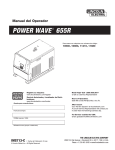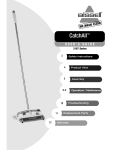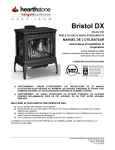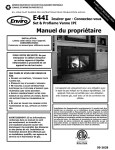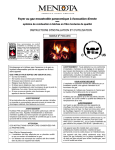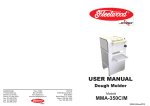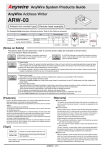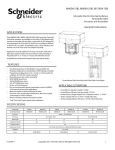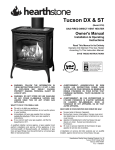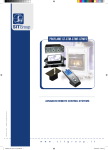Download Montigo GTMS Troubleshooting guide
Transcript
9.957.074 00 PROFLAME SYSTEM TROUBLESHOOTING GUIDE This document is intended to be to be used by the appliance manufacturer only and is not to be distributed to field service personnel or the end user. Scope This document is intended to be used in combination with the instruction manuals for each of the Proflame system components to aide in trouble-shooting and solving problems that may arise with the Proflame system. The appliance manufacturer’s instructions shall always supersede the information contained within this document. This document is intended to be used as a guide only, and must not be used to establish conformity of system components with OEM specifications, local codes, or certification standards. 1 Brief description of the system The Proflame System can be comprised of these elements specifically designed to be used in conjunction with • A stand-alone Proflame system o Proflame DFC: the flame ignition and control board o Proflame DFC main wirings harness o Proflame pilot assembly o Proflame 885/886 gas valve o Proflame power supplies • Remotely controlled Proflame system o Proflame DFC: the flame ignition and control board o Proflame DFC main wirings harness o Proflame pilot assembly o Proflame 88# gas valve o Proflame GT* Transmitter o Proflame GT* Receiver o Proflame GT* main wirings harness o Proflame GT Fan Control Module, or power supplies o 540 split flow valve in which the “#” character will be: - “0” if a non modulating valve is used, - “5” if an electronically modulation valve is used, - "6" if a manually adjustable modulating valve is used, and the “*” string will be the composition of the following characters: - “blank” if a non-modulating, or manually adjustable valve is used, - “M” if an electronically modulating valve is used, - “F” if the Fan Control Module peripheral is used, this will also supply power to the whole system, - “S” if the Split Flow Valve is used. 2 Brief description of the components 2 The Proflame control is available in three different configurations. The 880 Proflame provides basic ON/OFF operation of gas flow to the pilot and main burners of the heating appliance. The 885 Proflame provides the same basic functions as the 880 Proflame while also allowing for electronic modulation of the gas pressure to the appliance burner. The 886 Proflame offers the same functions as the 885 control except that it is fitted with a manual HI/LO knob to allow for manual modulation of the gas outlet pressure to the appliance burner. The Proflame controls are designed to be used with either LPG or Natural Gas and can be converted by use of an OEM supplied conversion kit. The 880 valves can also be upgraded to 885 or 886 configurations by installing OEM supplied conversion/ kits. The Proflame 584 Digital Fireplace Control (DFC) is an automatic gas ignition system based on a single microcontroller core. This family of controls is suited to manage all functions related to ignition, flame sensing and supervision for atmospheric applications. The Proflame DFC can be set to provide continuous or intermittent ignition control sequences and flame monitoring with safety shutdown in case of failure. The Proflame DFC can be set up as a stand alone AC powered system with battery back up. When used with the Proflame 584 Remote Control System the Proflame DFC can be supplied with AC power from either an AC wall adaptor or the Fan Control Module via the remote receiver. The Proflame receiver supplies battery back up power for both configurations. The Proflame GT Series is a modular remote control system that directs the functions of a hearth appliance. The Proflame GT is configured to control the ON/OFF and flame level of the main burner and provides on/ off and Smart thermostatic control of the hearth appliance. The system controls a remotely actuated 120V/60Hz power outlet, Fan speed through six (6) levels and has a constantly powered 120V/60Hz power outlet. The Proflame Receiver (fig. 1) connects directly to the gas valve, stepper motor and Fan Control Module with a wiring harness. The receiver is powered by (4) AA type batteries. The receiver accepts commands via radio frequency from the Transmitter to operate the appliance in accordance with the particular Proflame system configuration. The three-position slider switch on the receiver can be set to any of the three positions: ON (Manual override), Remote (Remote control) or Off. The Proflame Remote Control System consists of a transmitter and receiver that, when used in conjunction with a combination gas control valve, controls the functions of the gas hearth appliance. It is capable of providing ON/OFF and thermostatic control of the appliance when used in it’s most basic form, or may be configured to work with an electronically modulating control to provide variable flame height and Smart thermostat operation. The system can be further upgraded to include a Fan Control Module that is capable of controlling power to a remotely controlled ON/OFF 120V/60Hz outlet, a constantly powered 120V60Hz power outlet, and a variable outlet that provides six (6) different fan speeds. The Proflame Transmitter uses a streamline design with a simple button layout and informative LCD display. A Mode Key is provided to index between the features and a Thermostat Key is used to turn on/off or index to through the Thermostat functions. The Proflame GT Series is a modular remote control system that directs the functions of a hearth appliance. The Proflame GT is configured to control the ON/OFF and flame level of the main burner and provides on/off and Smart thermostatic control of the hearth appliance. The Proflame Fan Control Module (FCM) offers the added ability to control the fan speed from off through six (6) speeds, a remotely actuated 120V outlet in addition to providing a constantly powered 120V outlet. The FCM provides DC power to the receiver & DFC board allowing the batteries to be used only when line power is interrupted or lost. - The Split Flow burner controller has one inlet and two outlets. The inlet is connected to the outlet of the appliance main safety valve, while the outlets are connected to the primary and secondary burners respectively. The primary outlet is always open, simply allowing the gas flow from the safety valve to the primary burner. The secondary outlet is controlled by the Split Flow and can be open or closed at the user request. A 6VDC pulse is applied to the solenoid which opens a valve allowing gas to flow to the burner. The valve will remain open until a pulse of opposite polarity is applied to the coil. The Split Flow is NOT a safety device, and is only used for controlling burner sections in a gas appliance. The appliance manufacturer must verify that the burners light correctly when the appliance is put into operation with either one or two burners being lit at a time. The Split Flow is fully compatible for use with the Proflame remote control system. 3 3 Basic configuration schematics Standalone Proflame system (Fig.1) ON / OFF CPI / IPI MODE Orange ON/OFF Green IPI/CPI Battery Holder Red Black 880/886 Proflame VALVE BATTERY 120 Vac INPUT 7 Vdc STABILIZED SUPPLY OUTPUT Chassis connection GROUND DFC DC SUPPLY Fig. 1: electrical connections of standalone Proflame system 4 GTMFS Proflame system (Fig.2) REMOTE 120V OUT REMOTE MOTOR FCM-COM Orange Pilot Green Pink Receiver 14 Pin Connector Blue Split Flow RECEIVER 885 PROFLAME SPLIT FLOW GROUND TPTH TH ON / OFF Chassis connection Remote control DC SUPPLY DC SUPPLY IPI/CPI Fig. 2 CPI / IPI MODE GTMS Proflame system (Fig.3) 120 Vac INPUT 7 Vdc STABILIZED SUPPLY OUTPUT REMOTE REMOTE MOTOR DC SUPPLY Orange Green Pilot Pink Receiver 14 Pin Connector Blue Split Flow RECEIVER 885 PROFLAME SPLIT FLOW GROUND TPTH TH Remote control ON / OFF Chassis connection DC SUPPLY DFC SUPPLY Fig. 3 IPI/CPI CPI / IPI MODE 5 4 Tools Multimeter Flat-head Screwdriver Manometer Phillips-head Screwdriver Test Wire 5 Troubleshooting Before proceeding with the procedures in the following troubleshooting table, verify that the power supply (AC/DC adapter or Fan Control Module) is present and that the batteries inside the receiver and/or optional battery pack are fresh and installed with correct polarity. Make sure all the connections between the wire harnesses and system components are proper and positive. Make sure the communication link between transmitter and receiver is established (see Operating Procedure of 9957035 GTMF Installation manual). Verify that the static inlet pressure meets the manufacturer’s recommended inlet pressure. If necessary adjust the line pressure regulator. If the recommended actions for the following troubleshooting flow chart do not help to address the problem consider replacing wiring harnesses. See Troubleshooting flow chart. In case of doubt contact us before to proceed. WARNING 6 Any actions performed on the gas valve must be performed in accordance with the gas valve instruction manual. Likewise, any actions performed on the DFC or other system components must be done in accordance with the with the individual component instruction manuals. Replacement of components must be performed in accordance with the manufacturer’s instruction manual. Troubleshooting flow chart 1 If the DFC giving signal lock out. The board should be unlocked to reinitiate a pilot flame ignition (for the correct unlock sequence refer to the DFC Use and Installation Instructions) Pilot flame is ON NO Is the DFC board in lock out NO 1. Verify the electrical connections integrity and make sure they are in accordance with the relevant system wiring diagram. If necessary replace the wire harness. 2. Replace the DFC board. YES 1. Check the spark electrode positioning - adjust as necessary (for the correct distance refer t o the Pilot burner user installation manual) Was observed spark at the Pilot Hood before the DFC board locked out 2. Replace the spark cable, or the cableelectrode assembly, or the pilot assembly NO 3. Verify the electrical connections integrity and make sure they are in accordance with the relevant system wiring diagram. If necessary replace the wire harness. 4. Replace the DFC board. 1. Verify the electrical connections integrity and make sure they are in accordance with the relevant system wiring diagram. If necessary replace the wire harness. YES YES 2. If pilot flow adjuster screw is not sealed; check if pilot flow adjust screw is set correctly in accordance with the appliance manufacturer instructions. If necessary correct it. 3.Replace pilot tube or complete pilot assembly. 4.Replace the pilot orifice with a new orifice of correct size, and type, or replace the pilot assembly. Under all circumstances follow the appliance manufacturer's service instructions. 5. Remove the provided wiring harnesses from EV1 of gas valve (red base), and verify voltage at ignition between the EV1 terminal and the ground connection on the valve body. If the voltage is greater then 0 then Replace Valve. Otherwise Replace DFC Spark continues while the pilot is ON NO 2 YES 1. Replace the sense cable, or the cablesense electrode assembly, or the pilot assembly 2. Replace the DFC board 7 2 Main burner lights when the pilot only should light 1. Replace DFC board YES 2. Replace the gas valve 1. Verify the pilot flame fully engulfs the tip of the sense electrode. If not replace the pilot assembly. NO 2. Replace the sense electrode. 3. Carefully clean the electrical connections of the sense cable, and the DFC board sense cable connection. Pilot holds the flame? NO 4. Replace the sense cable, or the cable- sense electrode assembly, or the pilot assembly 5. Verify the pilot is properly grounded, and there is no damage to the ground cable. If necessary replace the pilot ground cable . 6. Replace the pilot orifice with a new orifice of correct size, and type, or replace the pilot assembly. Under all circumstances follow the appliance manufacturer's service instructions. 7. If pilot flow adjuster screw is not sealed; check it in acordance to appliance manufacturer instruction. If necessary correct it YES 1. Verify the electrical connections integrity and make sure they are in accordance with the relevant system wiring diagram. If necessary replace the wire harness. 2. Check if the remote transmitter is in thermostat mode and verify there is a call for heat. Adjust the setting for heat. 3. Verify that the pilot hood is properly fitted and a pilot flame is directed to properly ignite the main appliance burner. Main burner ignites? NO 4. Replace the main burner orifice with a new orifice of correct size, and type, or replace the pilot assembly. Under all circumstances follow the appliance manufacturer's service instructions. 5. Remove the provided wiring harnesses from EV2 of gas valve (red base), and verify voltage at ignition between the EV1 terminal and the ground connection on the valve body. 5.1 If the voltage is greater then 0 then Replace Valve. 5.2 Or Replace DFC 6. Check the pressure at the outlet pressure test point out according to the manufacturer instruction. If not in accordance replace the gas valve. YES 1. Verify the electrical connections integrity and make sure they are in accordance with the relevant system wiring diagram. If necessary replace the wire harness. 2. Check the pressure at the outlet pressure test point out according to the manufacturer instruction. If not in accordance replace the gas valve. Main burner remains ON YES 8 3 NO 3. With the system in the OFF position, connect the voltmeter between the EV2 terminal (green base) on the valve, and the ground on the valve body. Turn the system ON, let the pilot light, and observe the following voltage sequence: once the pilot flame is proved, the voltage on EV2 should spike to approx. 5 VdC for approx. 2 sec and then drop to approx. 0.6 Vdc continuously. 3.1 If the sequence is respected, replace the gas valve. 3.2 If the sequence is not respected, replace the DFC board. 1. Replace the main burner orifice with a new orifice of correct size (partial blckage possible). Verify that the main burner flame modulates.If it does not modulate replace the gas valve. 3 2. Verify that the gas valve outlet pressure limits are in accordance with the manufacturer specifications. If not replace the gas valve. Main burner modulates properly? NO FOR MANUAL HI/LO VERSION 3. Verify the flame changes while rotating the HI/LO knob on the front of the gas valve. If there is no change replace the gas valve. FOR STEPPER MOTOR VERSION 4. Check for the proper electric connections, and inspect the stepper motor wiring for damage. If the stepper motor wiring is damaged, replace the gas valve. 5. Replace the transmitter. 6. Replace the receiver YES 7. Replace the gas valve 4 9 4 Turn Fan ON via transmitter Fan turns on? NO Are you using remote transmitter GTMF or GTMFS? YES NO 1.Replace transmitter with GTMF or GTMFS version 1. Verify the FCM is connected to the AC Power and switch it ON. 2. Verify the electrical connections integrity and make sure they are in accordance with the relevant system wiring diagram. If necessary replace the wire harness. YES 3. Unplug the fan from the Fan outlet of FCM, and plug it into the appliance 120V supply. 3.1 If the fan works replace the FCM. 3.2 If the fan doesn't work, replace the fan and connect to fan outlet. 1. Verify the FCM is connected to AC Power and is ON and that the Fan is plugged into the FCM receptable marked FAN. If not do it. Fan RPM changes in accordance with trasmitter commands NO 2. Verify that the pilot ground wire connection is properly connected to the appliance chassis, as per the DFC installation manual.. 3. Replace FCM. YES 1. Verify the FCM is connected to AC Power and the Aux devices are plugged in. 2. Verify that the DFC board is properly grounded to the appliance chassis as per DFC board Use and Installation Instruction. If not make proper ground connection. Aux devices work as commanded by transmitter NO 2. Unplug the Aux device from the Aux outlet of FCM, and plug it into the appliance 120V supply. 2.1 If the Aux device works replace the FCM. 2.2 If the Aux device doesn't work, replace the aux device and connect it to Aux outlet. YES 1. Verify the Transmitter has Split flow features. Split flow works as commanded by the transmitter NO 1. Verify the electrical connections integrity and make sure they are in accordance with the relevant system wiring diagram. If necessary replace the wire harness. 2. Replace Split Flow. YES 10 END Receiver - transmitter troubleshooting flow chart Rx-TX comm Replace receiver battery with new ones Is receiver beeping? NO 1. Replace the receiver YES Replace transmitter battery with new ones 1. move closer transmitter to receiver Pushing ON/OFF button of transmitter is receiver beeping? NO 2. resynchronize the receiver and the transmitter 3. replace the transmitter with a correct type version YES END 11 OFF command troubleshooting flow chart OFF command 1. Verifiy transmitter-receiver communication Main burner turns OFF? NO 2. Remove the electrical wire connector from the EV1 (green base) and EV2 (red base) on the gas valve. If the main burner still remains lit continuously, turn off the gas supply to the appliance, and replace the gas valve. YES 1. Verify the status of the IPI/CPI switch. If the IPI/CPI switch is in CPI position the system behaves as expected.Otherwise, check with manufacturer's instruction manual. Pilot turns OFF? YES END 12 NO 2. Remove the electrical wire connector from the EV1 (green base) on the gas valve. If the pilot still remains lit continuously, turn off the gas supply to the appliance, and replace the gas valve. 6 Additional troubleshooting information 6.1 DFC power supply verification Battery supply test Switch off the FCM if present. Measure voltage between CN1.1 (+) and CN1.3 (-) at the DFC board (see wiring diagram in the DFC installation manual). The measured voltage should be between 4.4Vdc and 6.4Vdc. Less than 4.4Vdc could indicate drained batteries. To be also sure, each single battery level should be measured greater than 1.1Vdc. 6.2 AC/DC supply test Turn FCM ON or plug in the AC/DC adapter. Measure voltage between CN1.2 (+) and CN1.3 (-) at the DFC board (see wiring diagram in the DFC installation manual). The measured voltage should be between 6.7Vdc and 7.3 Vdc for the AC/DC adapter. The measured voltage should be between 6Vdc and 6.4 Vdc for the FCM. 7 Available documentation CODE 9957018 9957039 9957063 9957061 9957015 9957016 9957017 9957028 9957029 9957030 9957031 9957032 9957035 9957036 9957037 9957038 9957014 9957100 7252627 7252628 7252638 7252639 DESCRIPTION 880 PROFLAME Use and Installation Instructions 885 PROFLAME Use and Installation Instructions 886 PROFLAME Use and Installation Instructions PROFLAME DFC Use and Installation Instructions GT System Use and Installation Instructions GTM System Use and Installation Instructions GTMF System Use and Installation Instructions Prolame GTMF System Use and Instructions Proflame System with the SPLIT FLOW feature 584 Proflame GTMF Transmitter 584 Proflame GTMF Receiver 584 Proflame GTMF Fan Control Module 584 Proflame GTMF System 584 Proflame GTM System 584 Proflame GT System 584 Proflame Receiver (S) Split flow Use and Installation Instructions Pilot Burner Use and Installation Instructions PROFLAME HI/LO conversion kit PROFLAME Stepper motor conversion kit Assembly instructions (LPG) Assembly instructions (NG) LANGUAGE GB GB GB GB FR FR FR FR GB GB GB GB GB GB GB GB GB GB GB GB GB GB GB 13 This page is intentionally left blank 14 This page is intentionally left blank 15
















